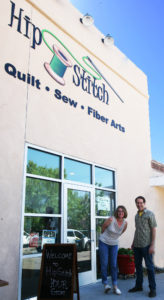 Store name: Hip Stitch
Store name: Hip Stitch
Owners: Suzanne Kelly and Steve Hamlin. (It was started in 2008 by Suzanne and two friends—three PTA moms who wanted to create a place where people could learn to sew.)
Store location: 2320 Wisconsin NE, Albuquerque, NM 87110; Hip Stitch was originally located in a strip mall in the suburbs of north east Albuquerque. In February 2017, we more than doubled our sales floor and class space when we relocated to our own building, which is architecturally styled like territorial buildings often seen in Northern New Mexico.
Phone: 505-821-2739
Region of the country: Southwest
Years in business: 11
Number of Employees: 15
Website: www.HipStitchABQ.com
Facebook: Facebook.com/hipstitchabq
Pinterest: pinterest.com/hipstitchabq
Instagram: instagram.com/hipstitchabq
Twitter: twitter.com/hipstitchabq
YouTube: youtube.com/
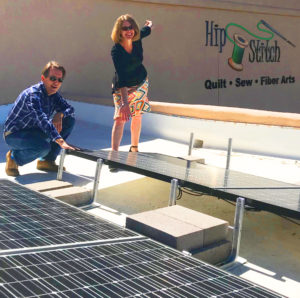 In New Mexico, quilters, garment makers, and fiber artists can accumulate the supplies they need to be successful – including classes that keep them up-to-date on new techniques. And to control their bottom line, Hip Stitch even generates their own electricity through solar power!
In New Mexico, quilters, garment makers, and fiber artists can accumulate the supplies they need to be successful – including classes that keep them up-to-date on new techniques. And to control their bottom line, Hip Stitch even generates their own electricity through solar power!
Types of special services offered: In addition to sales of fabrics, patterns, notions and supplies for quilting and sewing, Hip Stitch offers supplies for knitting, machine and hand embroidery, sashiko and wool applique. We offer supplies for fabric dyeing, painting and stamping. We also sell Eversewn sewing machines, customize Featherweight sewing machines and offer machine repair and service.
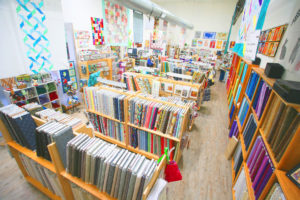
A further word about machine tech Jeremi and what he brings to Hip Stitch: He is one of Albuquerque’s best sewing machine technicians and does machine cleaning and repair, as well as scissors sharpening. He also restores vintage machines and runs the Hip Stitch Featherweight division. We repair customers’ Featherweights but we also do custom refurbishing and paint our own stock of Featherweights or those brought in by customers.
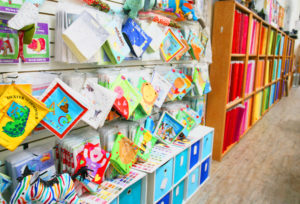
We work with an award winning painter to render jazzy custom colors–such as turquoise blue, desert sunset red or cactus flower yellow. Our painter, New Mexican artist Danny B., has even custom painted Dia de Los Muertos and Dragon-themed Featherweights. This division has grown to include a full Featherweight store-within-a-store, where we package and sell accessories, tools and add-ons for Featherweights.
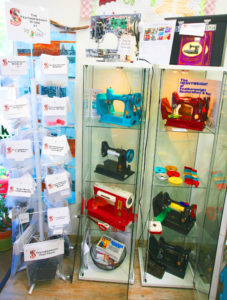
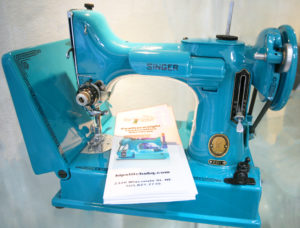
Hip Stitch is also the only certified Kimberbell machine embroidery dealer in New Mexico and the only brick-and-mortar retailer of Cherrywood hand-dyed fabrics in the Southwest.
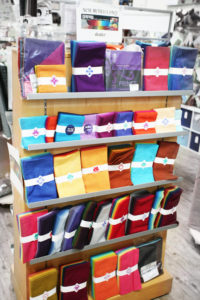
Is your business brick and mortar, online, or a combination of both? We have both brick-and-mortar and online sales and are evaluating expanding running sales booths at regional shows.
What kind of community is your store located in? We’re a few doors up from Kaos, but right next door to God’s House. Our shop is near a busy retail intersection, but we are set one block in, on the edge of a residential neighborhood. Kitty corner across the major intersection is a Joann Fabrics, with a WalMart that sells fabric in the mall next to it.
Our next door neighbor is a church called “God’s House”. Other small businesses nearby include a jeweler, a bookstore, a tailor and a few doors down, Kaos Kustom Fangs (apparently, that’s a thing).
What are the store successes you’re most proud of? The creative fiber arts community we’ve gathered and grown. Our customers are part of the Hip Stitch family, and that’s the key to our reputation as the friendliest shop in town.
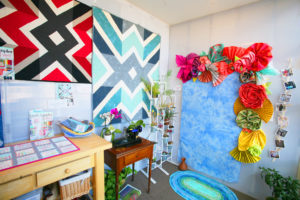 Your website slogan – the happiest quilt store on earth – sets the tone for your store. How do you hire new employees so they fit with your motto? We hire for smart and we hire for nice. Everything else can be taught.
Your website slogan – the happiest quilt store on earth – sets the tone for your store. How do you hire new employees so they fit with your motto? We hire for smart and we hire for nice. Everything else can be taught.
Do you have an employee handbook? Along with an employee handbook, we have staff meetings, task force meetings, staff newsletters and a day book for shift notes. We’re lucky in that many of our staffers have worked for schools, medical professionals and in publishing, so they understand how critical peer-to-peer communications is in advancing the business.
How long do most employees stay with you? We have one who has been with us since the beginning, some 11 years ago! The majority, though, have been with us 4-7 years. We also hire teens (who are great workers, by the way). In fact, we just welcomed one teen back from college for the summer, and the other two just graduated high school. We think our staff enjoys working here and stays with us because we invite them to grow into other areas of work at the shop, not just cut yardage at the counter. When someone has invested thought and planning into other areas of retail, the shop not only benefits from the fresh energy, but the employee benefits from the development of other skills. We have essentially modeled on a record label or movie studio — we provide the financial backing, the facilities and the marketing. Those who have a concept, pitch their idea. If it looks like it fits with the store’s mission and could be successful, we try to make it work.
With the variety of skills you cover – garment making, quilting, knitting, embroidery, sewing machines, clubs, gifts – how do you insure that you have the right products on hand? Good communications and modeling of business workflow are key to inventory management. Essentially, we work backwards with Gantt charting and critical path method, working back from a happy customer — our ultimate product — to logical starting points, modeling to pinpoint our milestones for managing projects and necessary resources.
Do you rely on a POS system to help you manage inventory? We use the LikeSew software system point of sale, inventory management and website and online sales. It’s a POS that cannot be matched. Some days, words cannot express the place which LikeSew holds in our hearts.
Do you do a physical count annually? Which month? We conduct rolling inventory, with each category getting counted two to three times a year. Spot inventories, by category or by item are conducted as needed, in order to confirm the unheard of accuracy in reporting provided by the LikeSew POS.
You have an interesting curation of fabrics in your store. Who is responsible for making the choices? Steve and Suzanne have some input, but most of the frontline buying is done by a team of staffers who monitor inventory, open to buy (OTB), sales and anecdotal info from other staffers, our customers and industry news sources. The buying team attends Fall Market, and they meet with all fabric company reps who come through the store.
Managing our OTB has been a recent focus for Hip Stitch. They have a lot of knowledge about inventory flow, and have added to that by attending seminars at Quilt Market and other industry and manufacturer events. That has led to a more orderly use of OTB dollars, which means we have been able to take advantage of manufacturer promotions and special overstock sales. Closely tracking when new collections will arrive has meant we can more efficiently harness our marketing/social media engine to help with timely promotion.
What do you look for when you’re selecting new fabrics? Hip Stitch defines itself as “Southwest Modern,” so most fabric decisions stem from those two aesthetics. We have the biggest collection of Southwestern, Dia de Los Muertos and Hispanic-themed fabrics in New Mexico, as well as a strong selection of modern prints, modern batiks and luxe garment fabrics, including knits, linens and rayon blends.
How often do you see fabric reps? The buying team sees fabric reps about 1 to 2 times a month on average. Since the fabric companies tend to release their new collections coincident with Quilt Market, this is only approximate — weeks may lapse with no meetings followed by two or three appointments in a single week.
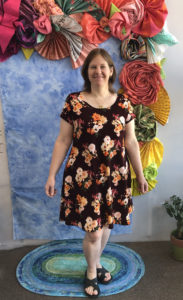 Your photo booth with the fabric flowers draws a lot of attention at your store. Whose idea was this and how are customers responding to it? This was a special photo backdrop created by staffer Melissa Levrets in tandem with our social media manager Mandie Segura to celebrate Me Made May, a cyber event created to focus on the growing popularity of garment sewing. Our version of the red carpet this year, used a blue rug, instead. (FYI, Melissa used Terial Magic fabric stiffener to create this masterpiece.) Throughout May, we invited customers (and staff!) to model their garments or show off their accessories and quilts in front of the photo background. We don’t show off our customers’ prowess in May only, though. We invite customers to share their finished projects with us anytime, and we pop a quick pic up on our Facebook to celebrate “the finish.” We also build promotions around this; if a customer brings in a quilt top they finished, using Hip Stitch fabric, we will take a photo, share it on FB, and the customer receives a 20 percent discount on their batting and backing.
Your photo booth with the fabric flowers draws a lot of attention at your store. Whose idea was this and how are customers responding to it? This was a special photo backdrop created by staffer Melissa Levrets in tandem with our social media manager Mandie Segura to celebrate Me Made May, a cyber event created to focus on the growing popularity of garment sewing. Our version of the red carpet this year, used a blue rug, instead. (FYI, Melissa used Terial Magic fabric stiffener to create this masterpiece.) Throughout May, we invited customers (and staff!) to model their garments or show off their accessories and quilts in front of the photo background. We don’t show off our customers’ prowess in May only, though. We invite customers to share their finished projects with us anytime, and we pop a quick pic up on our Facebook to celebrate “the finish.” We also build promotions around this; if a customer brings in a quilt top they finished, using Hip Stitch fabric, we will take a photo, share it on FB, and the customer receives a 20 percent discount on their batting and backing.
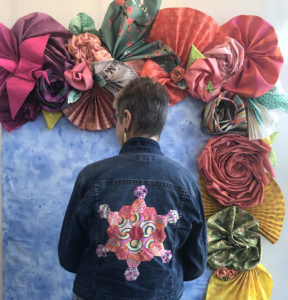
With the variety of classes you teach, which types do you teach the most? In 2019, we began planning and scheduling classes on a quarterly basis. Our education director, Susan Fakhrai, meshes teachers’ suggested topics and times with the Sewing Lounge calendar, and develops a class schedule. We release the class info in a color booklet at a Class Expo open house, where customers can visit with teachers, ask questions and see samples of class projects. This a great way to publicize current class offerings, and get ideas for future classes, based upon customer feedback.
We generally have 5 class categories:
- Quilting
- Sewing: including Basics and specific garment classes
- Handwork: including embroidery and sashiko
- Knitting
- Surface Fiber Art: including block printing, dyeing, collage
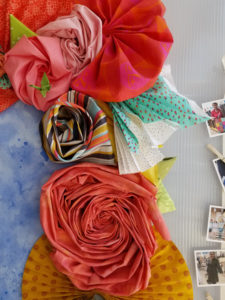 How do you determine class fees? Local teachers’ classes are generally priced at $10 per hour per student, which is at the top end of the local shop price range. We typically split that with our teachers. Out-of-town teachers have varying fees, but we usually price these at $100 per day student. (Visiting teachers’ classes are usually full-day workshops.) Our class policies cover all the areas that students would question.
How do you determine class fees? Local teachers’ classes are generally priced at $10 per hour per student, which is at the top end of the local shop price range. We typically split that with our teachers. Out-of-town teachers have varying fees, but we usually price these at $100 per day student. (Visiting teachers’ classes are usually full-day workshops.) Our class policies cover all the areas that students would question.
How do you manage classes and teachers? We have an internal policy document that outlines our expectations for teachers–both store staff and people from outside the store–for how classes are conducted and how we’d like teachers to connect the dots with products and services the store offers. Through the years, we’ve learned our share of lessons about what makes a great class from the teacher’s, student’s and store’s viewpoints. This policy has helped us be more consistent in the education we offer.
What is your policy for cancelling a class for low attendance or some other reason. We hate to cancel anything but are mindful of our Lounge use and our teachers’ time. Depending on projected class size, if there are fewer than 3 signed up, we will generally cancel, but will often leave the final decision up to the teacher.
Do you bring in designers from outside your area? Yes, we do! Every year we try to bring in nationally known teachers, sometimes connected with a new book release or with a new technique that’s trending. Our traveling teachers have included Jacquie Gering, Sherry Lynn Wood, Sarah Thomas, Gail Shannon and Kristi Schroeder. We also work with our local guilds to co-sponsor speakers like Angela Walters, Bill Kerr and others.
Who manages your social media? Mandie Segura leads the charge on our social media, including Facebook, Instagram and Twitter. However, other staffers can update our social media with images of activities, classes and customer projects as needed, especially if Mandie is not available.
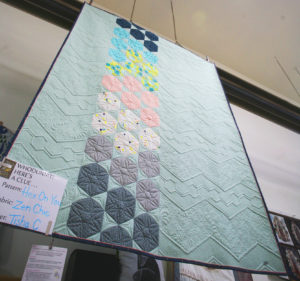 Does the same person update your website, too? Our website is largely managed by Susan Fahkrai, Melissa Levrets and Sarah Smith.
Does the same person update your website, too? Our website is largely managed by Susan Fahkrai, Melissa Levrets and Sarah Smith.
Do you use a content schedule or just update as you find something to show? Yes to both. Mandie, who also does the majority of our shop photography, coordinates closely with the buying team to highlight new fabrics and products. For special events, the coordinating staffer is tasked with posting activity as it happens.
Who keeps your blog updated? A variety of staff do this, as well as owners Steve and Suzanne. This is an area where we’re pushing for better planning and execution, especially of magazine-style content about technique, trends and people in our fiber arts community.
Where do you do the work of the business, such as bookkeeping, payroll, inventory management? Is there an office in the store or off site? Let’s just say our office situation is “fluid.” We have an office where Steve and Suzanne do administrative work, but this room also houses overstock inventory, transfer printing and sign making equipment and our Machine Tech department, which is run by Jeremi Chavez.
Some of our staff work from home on marketing, inventory management and planning tasks, but the main office always seems to have an extra person on hand, working on some project. And the Lounge, of course, doubles as a conference room when needed. Our payroll and bookkeeping are outsourced locally.
When is it accomplished? Steve and Suzanne try to make sure they have at least 1 1/2 to 2 days off each week. Like most store owners, the daily schedule is packed and there is always something else. The great part of owning your own business is that you only have to work half days. And you get to pick which 12 hours that’ll be.
Do you attend Quilt Market? Steve and Suzanne regularly attend Spring Market. The smaller market can be handled by two people. Fall Market requires a task force of four to eight. The preference is to send the store’s buying team, partly because those staffers are deeply enmeshed in the buying effort but also because the size of Fall Market requires more people to effectively work the event — to see all the exhibits, engage with all the vendors and attend concurrent classes. We consider continuing education to be a part of the store’s mission.
What do you look for when you attend market? Every one of us is looking for shifts in trends and styles. The owners and buying team are looking for means to better administer the business and improve operations. Those who work on social media, look for opportunities and ideas related to it. Everyone with a side interest — sashiko, for example — looks for trends in that sub-segment.
Do you bring staff, and if so, how do you compensate them? Any staff member can have a credential to go to any market if they’re traveling for their own edification. We pay a per diem, travel and lodging for those attending as our representatives. Depending on circumstance, we cover missed paycheck income, but many of our staff simply aren’t working for money.
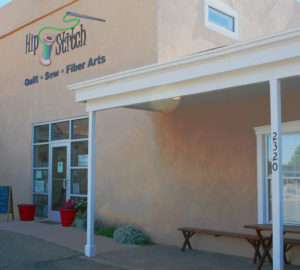 What has been the hardest part of running a store – and the easiest? The hardest is the amount of work — as owners, we don’t shut it off at 5:00. The easiest is being surrounded by creativity each and every day, customers who encourage us and share in our love of this place and staff members whose acting skills are so finely honed that it actually seems as if they enjoy working at Hip Stitch.
What has been the hardest part of running a store – and the easiest? The hardest is the amount of work — as owners, we don’t shut it off at 5:00. The easiest is being surrounded by creativity each and every day, customers who encourage us and share in our love of this place and staff members whose acting skills are so finely honed that it actually seems as if they enjoy working at Hip Stitch.
Strength Through Diversifying This is not just a popular social trend, but it’s actually the way Hip Stitch has been able to sustain its growth. We deliberately look for ways to add income streams that grow out of what we already do, connect with a growing trend or are in direct response to customer inquiry:
- In 2017, a customer mentioned she was interested in attending Quilt Festival in Houston but did not want to manage all the details of arranging such an excursion. She asked if we would, so we did. Our first Hip Stitch Festival Excursion headed to Houston in Fall 2018 with 15 travelers. Their stay included hotel, some meals, group show-and-tell and socializing, much swag and internationally known speakers at private group dinners. This excursion has laid the groundwork for more quilt event tours to come.
- We are actively developing a retreat program that would include one-day retreats at our location and multi-day retreats at nearby facilities. Our first Stitch Therapy day-long retreat will take place in late June 2019. Other topical retreats include one focused on “curvy sewing/garment fitting,” which is tentatively scheduled for November 2019 and a future luxury sewing retreat in a spa setting.
- Custom Invention & Design–Our first taste of this came with the development of Jerry’s Jelly Roll Jig, a device created to make it easier and faster to sew the popular Jelly Roll Rug. One of our staffers developed this jig with the help of a friend who had been an engineer at the National Labs. The Jig has been a strong seller, even finding its way to Australia through wholesale orders from other shops. It’s poised to go to the next level, as Moda/United Notions will distribute it beginning this summer.
- Custom-labeled products–We have a wealth of design talent on staff–and iconic Southwestern imagery surrounding us–and we’re using that to create custom Southwestern quilt blocks and patterns, small projects, embroidery kits, T-shirts and mugs. We also have relationships with several local artists and are including their original works–such as Chris Bruner’s macro sewing-themed greeting cards–in our retail setting.
- Our solar panel array went live a few days ago. We now generate our own electricity and so have eliminated another line item in the expense column.

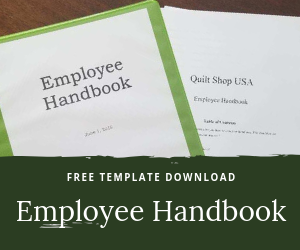
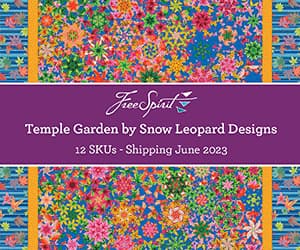

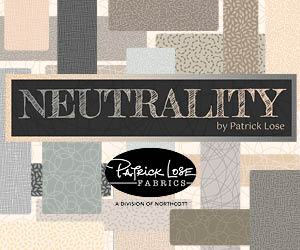
What a great write up with lots of information!! God read!’
Wonderful!